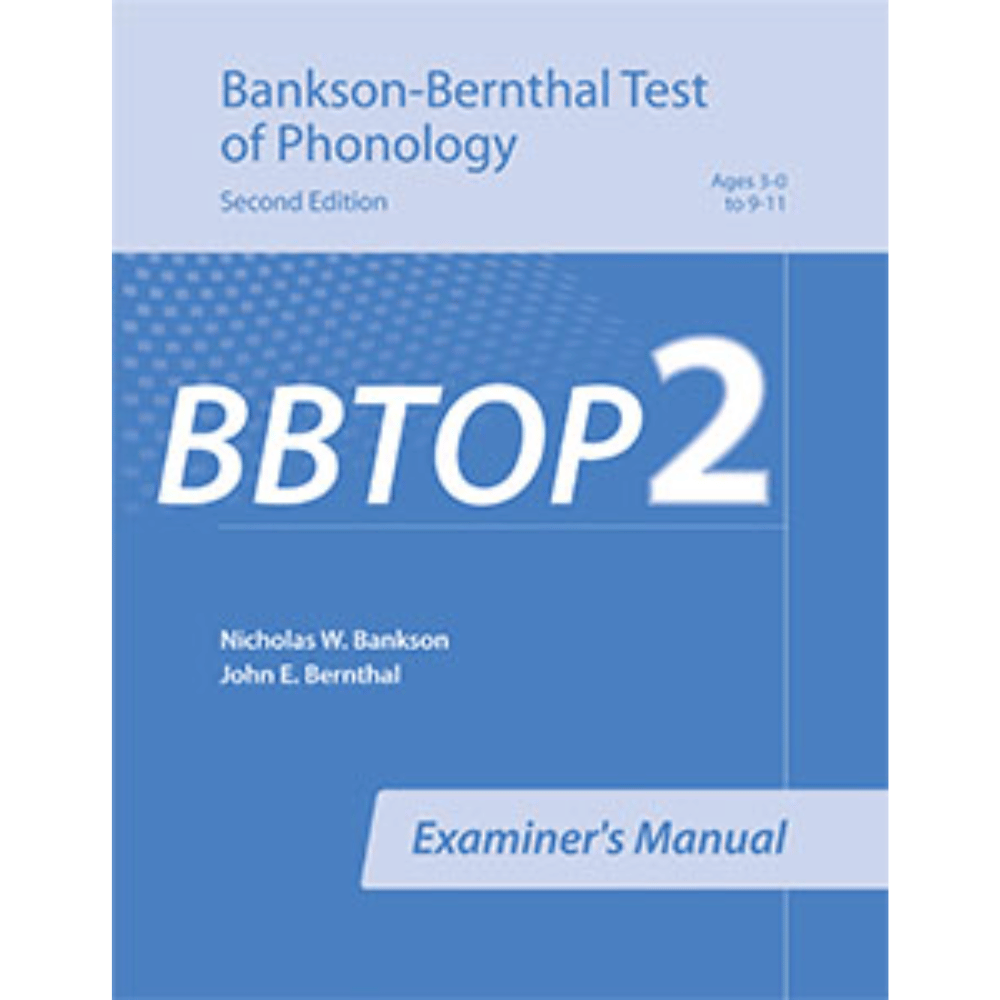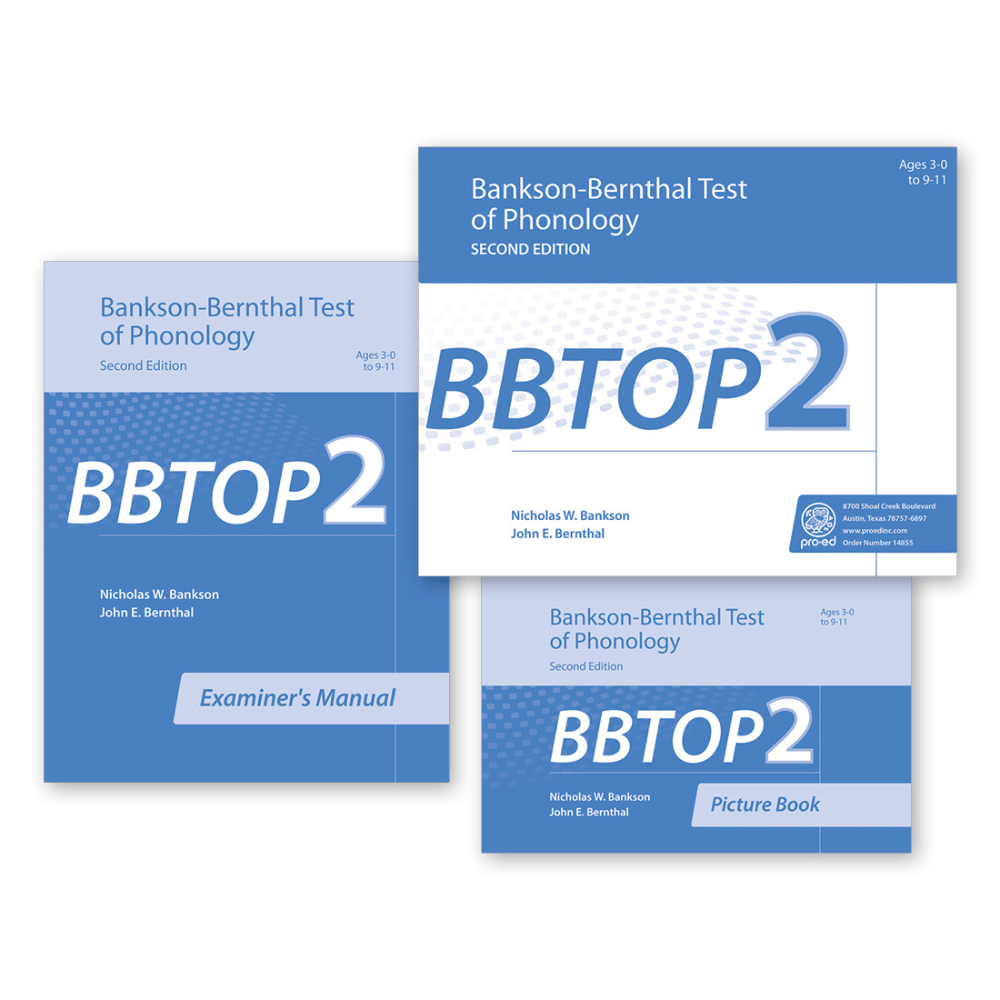BBTOP-2: Bankson-Bernthal Test of Phonology (Second Edition)
BBTOP-2: Bankson-Bernthal Test of Phonology (Second Edition)
By Nicholas W. Bankson & John E. Bernthal
Grades Pre-K - 3 | Ages 3 - 9
SKU:#14855
Couldn't load pickup availability
- We Accept Purchase Orders!
- Fully Secured SSL Checkout
- 30-Day Return Policy
Share
The Bankson-Bernthal Test of Phonology is an individually administered assessment of young children’s speech-sound development.
The test is actually three assessments in one: a whole-word accuracy analysis, an inventory of consonant articulation, and an assessment of common phonological error patterns.
Ages: 3-0 through 9-11
Testing Time: 15 to 20 minutes
Administration: Individual
What makes this phonology assessment so effective?
- Uses colorful illustrations to elicit 80 commonly known stimulus words.
- Stimulus words are preprinted in IPA on the record form for accurate transcription.
- Now includes a comprehensive stimulability testing section to inform treatment target selection.
- Backed by new item bias studies confirming minimal bias across gender, race, and ethnicity.
- Diagnostic accuracy measures show strong sensitivity (.81), specificity (.82), and ROC/AUC (.89).
- Includes a detailed Examiner’s Manual with scoring instructions, interpretation guidelines, and research foundations.
- Normed on a national sample of 770 children from 33 states, representing a wide range of linguistic and demographic backgrounds.
New Features of the BTTOP-2
- An all-new standardization sample was collected.
- The recording and scoring materials were made more user-friendly.
A comprehensive stimulability testing section was added to provide additional information relative to treatment targets.
- A set of item bias studies indicates that the BBTOP-2 possesses little or no bias in regard to gender, race, and ethnicity.
- New floor, ceiling, and item gradient studies were conducted for the test’s three indexes.
- A study of the test’s diagnostic accuracy was conducted. Diagnostic accuracy analyses are considered the most rigorous techniques for establishing a test’s validity. These analyses involve the computation of sensitivity and specificity indexes and receiver operating characteristic/area under the curve (ROC/AUC) statistics.
How to use the BBTOP-2
Colourful illustrations are used to elicit the child’s pronunciation of 80 common stimulus words. To administer the BBTOP-2, the examiner simply points to each illustration and has the child name it. The stimulus words are conveniently preprinted in the International Phonetic Alphabet (IPA) on the record form.
The examiner uses IPA to transcribe any words the child misarticulates. After the child has named all 80 stimulus words and test administration has concluded, the examiner uses the transcription of the misarticulated words to complete the Consonant Articulation Inventory, which assesses articulation of both initial and final consonants.
Finally, the examiner can complete the Error Pattern Assessment of common phonological error patterns that may be evident in the misarticulated words. The test’s results can be used to:
- Identify children who have speech-sound disorders
- Plan interventions
- Represent speech-sound development and speech-sound disorders in research studies.
Technical and Statistical Characteristics of the BBTOP-2
Norms
The BBTOP-2 was normed on a sample of 770 children from 33 states and 248 zip codes. The test yields normed scores for the Word Inventory, Consonant Articulation Inventory, and Error Pattern Analysis. The Examiner’s Manual includes a comprehensive discussion of the test’s theoretical and research-based foundation, item development, standardization, administration and scoring procedures, norms tables, and guidelines for using and interpreting the test’s results.
Reliability
The Word Inventory internal consistency reliability coefficient is .97, and the retest reliability coefficients for the Consonant Articulation Inventory and the Error Pattern Assessment are .87 and .88, respectively.
Validity
Validity studies demonstrate the test’s ability to differentiate children with speech-sound disorders and those without. Specifically, a Word Inventory cutoff score of 90 resulted in a sensitivity of .81, a specificity of .82, and a ROC/AUC of .89 in differentiating children with speech-sound disorders from children without.
The complete BBTOP-2 includes:
- Examiner’s Manual
- Picture Book
- 25 Record Forms
- 25 Summary Forms
- Sturdy storage box
©2020




